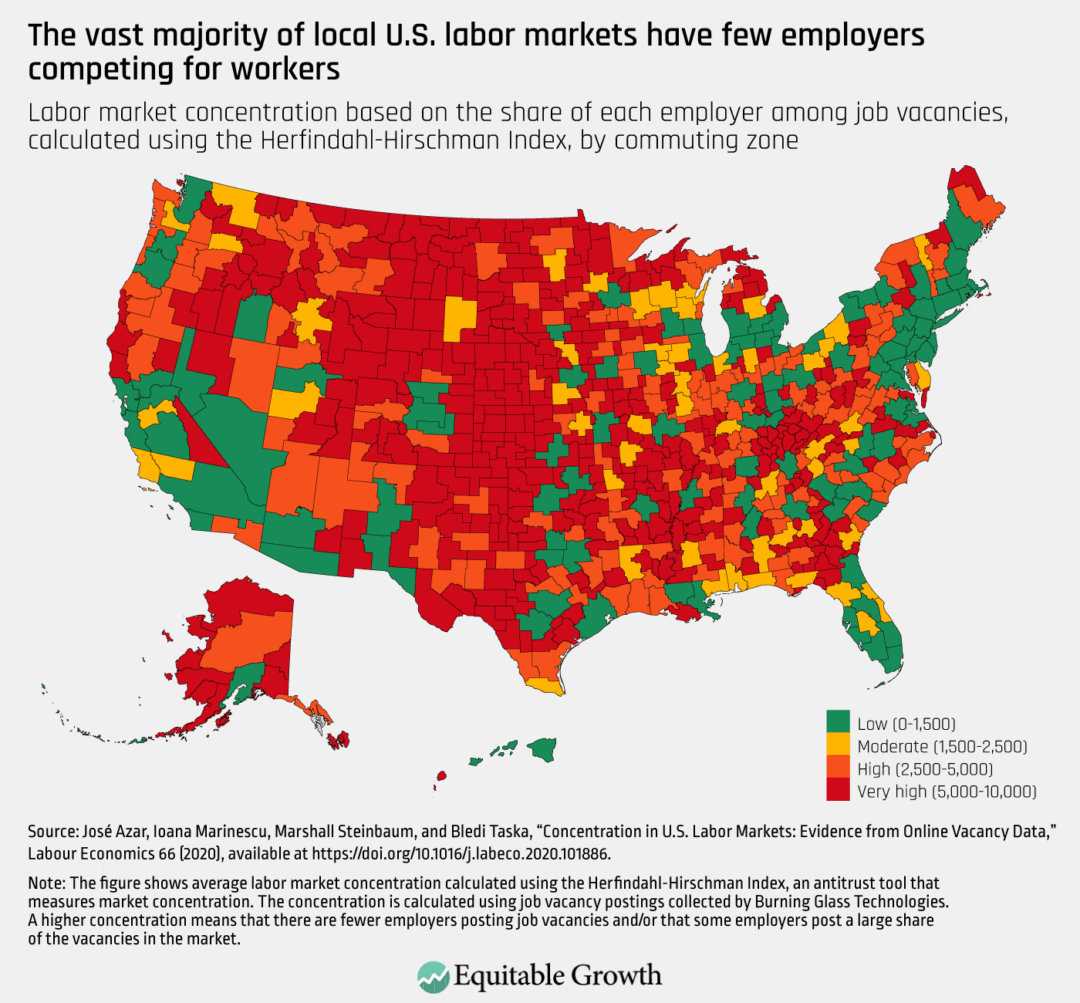Boosting wages when U.S. labor markets are not competitive

This essay is part of Boosting Wages for U.S. Workers in the New Economy, a compilation of 10 essays from leading economic thinkers who explore alternative policies for boosting wages and living standards, rooted in different structures that contribute to stagnant and unequal wages. The authors in the new book demonstrate that efforts to improve workers’ access to good jobs do not need to be limited to traditional labor policy. Policies relating to macroeconomics, to social services, and to market concentration also have direct relevance to wage levels and inequality, and can be useful tools for addressing them.
To read more about Boosting Wages for U.S. Workers in the New Economy 20 and download the full collection of essays, click here.
Overview
In many local labor markets across the United States, only a handful of employers compete for workers’ services. In these markets, employers can take advantage of their market power to underpay workers. Stronger antitrust enforcement can increase competition across all U.S. labor markets, thereby raising wages.
When labor markets are not competitive, two other well-known policy tools can also play a new role—unions and minimum wages. Increasing workers’ bargaining power by strengthening unions can counteract the effects of employers’ market power and increase wages. Similarly, a moderate increase in the federal minimum wage would lift workers’ pay without decreasing employment opportunities or existing jobs. An increase in the minimum wage can even create jobs in those parts of the country where there is little competition among employers.
In this essay, I will detail why so many workers are underpaid due to lack of competition for their labor among employers and how such labor market “monopsony” (the term for a monopoly in the labor market) suppresses wages. I will conclude with specific antitrust and labor market policy solutions to lift workers’ wages and incomes to create a more equitable U.S. labor market that contributes to stronger economic growth.
The problem: Workers are underpaid due to lack of competition among employers
Interest in policies that can boost wages is growing today because wage growth since 1980 has been very limited.1 Anemic wage growth is disconcerting because there have been steady productivity increases over the same period.2 To address this issue, a classic prescription from economics is to raise workers’ skills by increasing education. The thinking goes like this: If skills increase, then wages go up because workers are paid in proportion to their productivity. The fundamental assumption of standard economics is that wages exactly reflect workers’ productivity—their contribution to employers’ bottom lines.
This assumption is sensible if labor markets are perfectly competitive and there are no frictions in the way of workers finding good jobs that value their skills. If an employer underpays a worker, then that worker can credibly threaten to immediately quit for another job. Therefore, in such a perfectly competitive, frictionless labor market, employers cannot afford to underpay workers if they want to keep them around.
But if labor markets are not perfectly competitive, then education may not be the best tool to raise wages. And in the U.S. labor market, perfect competition is stymied for a number of reasons. One is the lack of competition among employers in many U.S. local labor markets, which makes it hard for workers to shop around for a better wage offer. Another reason is what economists call search frictions: It can be difficult for workers to efficiently search for jobs, for example, because they lack information on jobs far away from their homes. And a third is job differentiation: Jobs differ in many ways, beyond how much they pay. For example, some jobs may be close to a worker’s extended family, helping fulfill child care needs, and some jobs provide good health insurance, which is especially valuable to workers whose spouse has a chronic illness. When a job uniquely fulfills some of the worker’s personal needs, the employer has some leeway to pay the worker less than the value of their contributions.
For all of these reasons, raising workers’ skills may not be enough to significantly boost wages. In the extreme, if there is only one employer in the labor market, an increase in education does not increase workers’ wages at all. This is because workers cannot threaten to take their education elsewhere. Without competition, employers are the only ones to benefit from more education through higher productivity.
In the 1930s, economist Joan Robinson already thought about how employers could suppress wages. She coined the term “monopsony” by analogy to monopoly.3 While a monopoly is a situation where a single firm is supplying a product, monopsony is a situation where a single customer is buying a product. Applied to the labor market, monopsony is a situation where a single employer “buys” workers. This is obviously not perfect competition. While most labor markets have more than one employer, a handful of employers isn’t perfect competition either. More broadly, economists have been referring to labor markets with limited competition among employers as monopsonistic labor markets.
Monopoly in the product market has been widely studied by economists, and it is now well-known that product markets are often not perfectly competitive.4 If so, why should we expect labor markets to be perfectly competitive? Workers typically do not have that many options: Given the specificity of workers’ skills, as well as other relevant considerations such as commuting time, the number of good jobs for a given worker can often be counted on the fingers of one hand.
Monopsony is a real problem leading to less worker power, less labor market competition, and wage suppression. Policies that can address monopsony and its root causes will boost wages.
Monopsony in labor markets suppresses wages
If an employer can retain workers even when they underpay them, this opens the door to wage suppression. The concept of labor supply elasticity, which measures how sensitive, or “elastic,” workers are to wages, explains how much employers can afford to underpay their workers. If the labor supply elasticity is high, then workers are sensitive to wages, so an employer who underpays workers will run into serious recruitment and retention difficulties. Conversely, when the labor supply elasticity is low, workers are not very sensitive to wage changes, and employers can afford to underpay them without enduring high numbers of workers quitting to go to other jobs, alongside expensive and time-consuming efforts to recruit new workers.
In a competitive labor market, elasticity is high because workers can easily find another good job and will not tolerate being underpaid. With low labor market competition, elasticity is low because workers don’t have many good employment options, so they can’t afford to be picky about how much they’re paid.
To measure the labor supply elasticity in various U.S. labor markets, my co-authors and I recently leveraged data on job applications submitted to CareerBuilder.com, an online job-matching platform, to estimate how sensitive workers are to wages when applying for jobs.5 Given a number of assumptions, we can calculate how much profit-maximizing firms would underpay their workers, knowing that workers are not very sensitive to wages because of job differentiation. Our rough calculation implies that workers are about 17 percent more productive than the wages they receive. Our calculations also imply that wage suppression is similar for high-wage and low-wage types of jobs, despite the popular view that low-wage workers have more jobs from which to choose, say, as cashiers, retail sales clerks, restaurant servers, or dog walkers. But there are many ways in which jobs differ aside from skills. While low-wage workers may have more transferable skills, they care more about other aspects of the job, such as commuting time. Job differentiation is important for both high- and low-wage workers, leading to a similar amount of wage suppression.
Low labor supply elasticity measures how sensitive workers are to wage changes within a labor market, and therefore measures employers’ ability to keep wages low. The level of market elasticity answers the following question: how many more workers can a labor market attract and retain if wages increase? How much does accounting employment, for example, change in, say Washington, D.C. as wages increase? Are accounting firms in Washington able to attract more accountants from Peoria, IL, or other locations? Can higher wages in the accounting field attract Washington-area consultants with relevant skills?
My co-authors and I find that the market-level elasticity is much lower than the firm-level elasticity. This implies that workers are much more likely to change firms within a labor market than to change labor markets in response to a wage increase. If an accounting firm in my city offers higher pay, then I may well switch to that firm. Yet even if the pay for accountants is higher in another city, I may not be willing to relocate. This result makes sense, given that geographic mobility is low and declining.6 Furthermore, we know that most workers apply to jobs in their existing commuting zones. Eighty-one percent of job applications occur where the job applicant and prospective employer are within the same commuting zone.7
Besides looking at how sensitive workers are to changes in their wages, economists also can investigate how many employers compete for workers in a labor market. This gives another, complementary measure of the degree of competition in different labor markets. Specifically, labor market concentration is a way to measure the dearth of employers in a labor market. We can measure labor market concentration using the Herfindahl-Hirschman Index, which is what regulators already use for measuring the concentration of firms in product markets. The higher the concentration, the less competition there is in the labor market.
To calculate labor market concentration, my co-authors and I use data on all vacancies listed online in 2016, as collected by Burning Glass International Inc., a software company that operates the labor market data site burningglass.com.8 We find that U.S. labor markets tend to be highly concentrated, with an average HHI of 4,378, which is equivalent to 2.3 firms hiring in the case of equal number of job vacancies for each firm. Imagine that 50 percent of accounting jobs are posted by firm A, and the other 50 percent by firm B; this is roughly the degree of competition you can expect to find in the average U.S. labor market. Overall, 60 percent of labor markets in the United States are highly concentrated, according to the high concentration threshold defined by U.S. antitrust authorities’ 2010 Horizontal Merger Guidelines.9
These highly concentrated labor markets account for 20 percent of U.S. employment. Larger cities generally have lower labor market concentration, whereas rural areas tend to have more concentrated labor markets.10 These findings imply that many workers experience low labor market competition, and that workers in less-densely populated areas are especially affected. This may contribute to explaining why wages are higher in urban areas.11 (See Figure 1.)*
Figure 1

*Correction, January 21, 2021: This figure has been revised to reflect an updated version of the map.
Antitrust policy for U.S. labor markets
Federal antitrust authorities use powers granted under the Sherman Antitrust Act of 1890 to combat monopolies. From the time of the passage of this landmark legislation up to today, there is a clear sense that, left unchecked, companies will attempt to monopolize product markets, leading to inflated prices for consumers. Until recently, however, antitrust enforcers mostly did not acknowledge that employers can engage in similar anticompetitive behavior to suppress wages in labor markets.
Today, there is growing attention among labor market economists and antitrust authorities alike on the role of competition in labor markets, spurring a new set of empirical literature. This literature, including the evidence described in the previous section, shows that labor markets suffer from a lack of competition, which allows employers to suppress wages.
Yet federal antitrust enforcement remains focused on product markets, with almost no action to address a lack of competition in labor markets.12 Given the new evidence for a lack of competition, labor antitrust enforcement must be enhanced in the following ways:
- Corporate mergers should require monopsony antitrust investigation and enforcement.
- Labor market monopsony requires its own antitrust investigation and enforcement.
Let’s look at each of these enforcement issues in turn.
Corporate mergers should require monopsony antitrust investigation and enforcement
Company mergers that significantly increase labor market concentration should be scrutinized by antitrust authorities, following the same principles as for mergers in the product market.13 Mergers that threaten to produce anticompetitive wage suppression should be blocked. This is not a new policy but merely an expansion of existing antitrust enforcement to U.S. labor markets.
Blocking mergers that significantly increase labor market concentration will boost wages. Indeed, wages generally decrease when labor market concentration increases.14 Focusing on mergers specifically, economists documented that mergers decrease wages when labor market concentration significantly increased in the aftermath of the merger.15 The evidence ranges across an array of markets, including hospitals and manufacturing industries.
Strengthening merger enforcement and allocating more resources to federal antitrust agencies could already raise wages.
Strenthen antitrust enforcement across the board to better protect workers from anticompetitive harm
Beyond mergers, antitrust enforcement against monopsony conditions in U.S. labor markets should require its own set of investigation and enforcement actions. This expansion of antitrust enforcement would be facilitated by a new law that would codify, clarify, and, in some cases, strengthen antitrust law as it applies to labor markets. Such a law would guide the decisions of judges in labor antitrust cases and would facilitate the work of federal antitrust agencies.
This new ability to enforce anti-monopsony actions also would facilitate private litigation against companies that lower wages through anticompetitive conduct. To achieve this objective, we propose federal legislation that would clarify that the antitrust laws protect workers from anticompetitive abuses.16 The proposed bill, for the most part, draws on existing doctrine and concepts developed by courts for product-market litigation and applies them to labor markets.
Our legislative proposal begins with a simple restatement of Section 2 of the Sherman Act, except that we replace “monopolize” and related words with “monopsonize,” and add the term “labor market”:
It shall be unlawful for any employer engaged in commerce, in the course of such commerce, to monopsonize, attempt to monopsonize, or combine or conspire with any other person or persons to monopsonize, a labor market.17
We then define a set of anticompetitive behaviors for which employers with market power would be liable. Such anticompetitive behaviors include mergers, the use of noncompetition clauses (or noncompetes), and mandatory arbitration provisions in employer-employee wage and job disputes. These proposals would likely increase wages by strengthening competition in the labor market, which makes it harder for employers to underpay workers.
Unions counteract employers’ market power
Antitrust enforcement in labor markets would increase workers’ options within those labor markets, but unions can increase workers’ bargaining power within firms. Union households in the United States in the 20th century boasted about 20 percent higher incomes, while the decline of unions beginning in the last quarter of that century contributed to wage stagnation and growing income inequality.18
Specifically, unions counteract the negative effects of labor market concentration on wages. As detailed above, increases in labor market concentration tend to depress wages, yet this negative effect of concentration on wages is attenuated in the presence of unions.19 In other words, when labor markets become less competitive, unions are able to protect workers and keep their wages high, even though outside options are dwindling.
Worker power in the form of unions can thus counteract employer power. Unions are able to boost wages by weakening the adverse effects of a lack of competition in labor markets. This implies that policies that support unions could boost workers’ wages. More broadly, policies that enhance workers’ bargaining power have the potential to boost wages by counteracting the depressing effects of a lack of competition in the labor market.
Minimum wages and labor market competition
So far, we’ve seen that wages can be increased by strengthening competition using the antitrust toolbox and by boosting workers’ bargaining power with unions. Yet the most obvious solution to raising wages may well be raising the federal minimum wage. Instead of promoting wage increases through indirect mechanisms, this policy directly increases wages by simply mandating wage increases for the lowest-paid workers.
One common concern when raising minimum wages is that this could decrease employment opportunities. When you make labor more expensive, employers want to buy less of it, the argument goes. This all makes sense in a perfectly competitive labor market, where workers are paid according to their productivity. If you impose a minimum wage in such a competitive market, this thinking goes, then you are asking employers to pay some workers more than their productivity. Employers theoretically respond by laying off workers who are now too expensive, which results in employment declines.
But U.S. labor markets are demonstratively not perfectly competitive. When labor market concentration is high and competition is low, employers are underpaying workers even though firms can afford to pay their workers more. As long as the minimum wage is at or below workers’ productivity, employment should not decline. Instead, with a higher minimum wage, workers would get a raise and employment could even increase.
Ultimately, raising the minimum wage boosts wages directly by mandating a floor for low-wage workers while also generally offsetting employer monopsony power to undercut wages. My co-authors and I test this theory.20 We use U.S. labor market concentration to measure the degree of competition in a labor market. In competitive markets with low labor market concentration, which includes areas in and around most major cities (shown in the green and yellow areas in Figure 1), raising the minimum wage did have a slightly negative impact on employment, consistent with the basic economic theory that predicts that higher wages reduce the demand for labor.
But in less-competitive labor markets with high labor market concentration, such as those in less-densely populated areas of the country (shown in red and orange areas in Figure 1), raising the minimum wage increases employment. In those markets with high labor market concentration, employers could afford to pay more but faced little pressure to do so before a minimum wage increase. Because firms in these areas can underpay workers, employers could not attract as many of them, yet underpaying the workers they could get was more profitable than paying more and getting more workers. When the minimum wage increased, employers in high-concentration areas had to pay more and could afford to do so. This, in turn, allowed them to attract more workers and increase employment.
Overall, across all markets, my co-authors and I find that the effects of the minimum wage on employment is null because the employment increases in highly concentrated labor markets offset the employment decreases in less-concentrated labor markets.
Our finding can help explain why minimum wage increases often had no effect on employment, even though minimum wage increases sometimes decrease employment and sometimes increase it. The effect of raising the minimum wage depends on the state of competition in different labor markets—the less competition there is, the more likely it is that raising the minimum wage will actually increase employment and the less likely we are to see a negative employment effect.
These findings show that some opponents of raising the federal minimum wage are mistaken when they argue that more rural areas of the country would be harmed by a high wage floor. Our research shows that workers in more rural parts of the country are actually underpaid due to less-competitive labor markets. Raising the minimum wage in those areas may have no effect on employment or could even increase employment as more people are drawn into the labor market.
Nevertheless, policymakers need to exercise caution when increasing the minimum wage because setting it above workers’ productivity would decrease employment even in the presence of employer power. Prudent policymaking would raise minimum wages moderately and keep them close to worker productivity. The increase in overall labor productivity, together with the stagnation of the federal minimum wage since 2009, constitute a strong case for an increase in the federal minimum wage. Evaluating the employment effects of minimum wage increases will allow policymakers to adjust the policy as needed going forward. Currently, there is likely a lot of room to increase the federal minimum wage before we see a negative effect on employment.
Conclusion
In perfectly competitive labor markets, workers are paid according to their productivity. The classic solution to boosting wages, then, is to increase the education of workers so they become more productive. But as this essay demonstrates, U.S. labor markets are far from being perfectly competitive. Understanding this opens new avenues to boost wages.
Wages can be increased by making labor markets more competitive using antitrust enforcement. This action is especially important today because the coronavirus pandemic and resulting recession leads to consolidation pressures. Many businesses are failing, and large businesses find it easier to survive and then buy up smaller ones. More generally, amid the coronavirus recession, large businesses may argue that mergers increase their financial stability. Antitrust authorities need to resist mergers that will significantly increase labor market concentration and suppress wages.
Wages also can be increased by boosting workers’ bargaining power through strengthened unions. This will allow workers to better resist the downward wage pressures from reduced labor market competition among employers. Finally, when the labor market is not perfectly competitive, moderate minimum wage increases can be used to boost wages without worrying about a decrease in employment.
In sum, realizing that the labor market is monopsonistic rather than perfectly competitive allows policymakers to tap a broader set of policy tools to boost wages.
—Ioana Marinescu is an assistant professor of economics at the University of Pennsylvania School of Social Policy and Practice.
Acknowledgments

End Notes
1. Thomas Piketty, Emmanuel Saez, and Gabriel Zucman, “Distributional National Accounts: Methods and Estimates for the United States.” Working Paper (National Bureau of Economic Research, 2016), available at https://doi.org/10.3386/w22945.
2. Anna M. Stansbury and Lawrence H. Summers, “Productivity and Pay: Is the Link Broken?” Working Paper (National Bureau of Economic Research, 2017), available at https://doi.org/10.3386/w24165.
3. Joan Robinson, The Economics of Imperfect Competition (London: Macmillan, 1933).
4. John Sutton, “Chapter 35 Market Structure: Theory and Evidence.” In M. Armstrong and R. Porter, eds., Handbook of Industrial Organization, vol. 3 (Amsterdam: Elsevier, 2007), pp. 2301–68, available at https://doi.org/10.1016/S1573-448X(06)03035-4.
5. José Azar, Steven Berry, and Ioana Marinescu, “Estimating Labor Market Power.” Scholarly Paper (Social Science Research Network, 2019), available at https://papers.ssrn.com/abstract=3456277.
6. Raven Molloy, Christopher L. Smith, and Abigail Wozniak, “Internal Migration in the United States,” Journal of Economic Perspectives 25 (3) (2011): 173–96, available at https://doi.org/10.1257/jep.25.3.173.
7. Ioana Marinescu and Roland Rathelot, “Mismatch Unemployment and the Geography of Job Search,” American Economic Journal: Macroeconomics 10 (3) (2018): 42–70, available at https://doi.org/10.1257/mac.20160312.
8. José Azar and others, “Concentration in U.S. Labor Markets: Evidence from Online Vacancy Data,” Labour Economics 66 (2020), available at https://doi.org/10.1016/j.labeco.2020.101886.
9. U.S. Department of Justice and Federal Trade Commission, Horizontal Merger Guidelines (2010), 37.
10. Azar and others, “Concentration in U.S. Labor Markets.”
11. Nathaniel Baum-Snow and Ronni Pavan, “Understanding the City Size Wage Gap,” The Review of Economic Studies 79 (1) (2012): 88–127, available at https://doi.org/10.1093/restud/rdr022; Jeffrey J. Yankow, “Why Do Cities Pay More? An Empirical Examination of Some Competing Theories of the Urban Wage Premium,” Journal of Urban Economics 60 (2) (2006): 139–61, available at https://doi.org/10.1016/j.jue.2006.03.004.
12. Ioana Marinescu and Eric A. Posner, “Why Has Antitrust Law Failed Workers?,” Cornell Law Review (forthcoming, 2020).
13. Ioana Marinescu and Herbert Hovenkamp, “Anticompetitive Mergers in Labor Markets,” Indiana Law Journal 94 (3) (2019): 1031.
14. José Azar, Ioana Marinescu, and Marshall Steinbaum, “Labor Market Concentration,” Journal of Human Resources (2020), available at https://doi.org/10.3368/jhr.monopsony.1218-9914R1; Efraim Benmelech, Nittai Bergman, and Hyunseob Kim, “Strong Employers and Weak Employees: How Does Employer Concentration Affect Wages?” Working Paper (National Bureau of Economic Research, 2018), available at https://doi.org/10.3386/w24307; Kevin Rinz, “Labor Market Concentration, Earnings Inequality, and Earnings Mobility.” Working Paper (Center for Economic Studies, U.S. Census Bureau, 2018), available at https://kevinrinz.github.io/concentration.pdf; Yue Qiu and Aaron Sojourner, “Labor-Market Concentration and Labor Compensation.” Scholarly Paper (Social Science Research Network, 2019), available at https://papers.ssrn.com/abstract=3312197; Ben Lipsius, “Labor Market Concentration Does Not Explain the Falling Labor Share.” 2018 Papers (Job Market Papers, 2018), available at https://ideas.repec.org/p/jmp/jm2018/pli1202.html; Brad Hershbein, Claudia Macaluso, and Chen Yeh, “Concentration in U.S. Local Labor Markets: Evidence from Vacancy and Employment Data.” Meeting Papers (Society for Economic Dynamics, 2019), p. 40.
15. David Arnold, “Mergers and Acquisitions, Local Labor Market Concentration, and Worker Outcomes.” Scholarly Paper (Social Science Research Network, 2019), available at https://papers.ssrn.com/abstract=3476369; Elena Prager and Matt Schmitt, “Employer Consolidation and Wages: Evidence from Hospitals.” Working Paper (Washington Center for Equitable Growth, 2018).
16. Marinescu and Posner, “Why Has Antitrust Law Failed Workers?”
17. Ioana Marinescu and Eric A. Posner, “A Proposal to Enhance Antitrust Protection Against Labor Market Monopsony” (New York: Roosevelt Institute, 2019), available at http://rooseveltinstitute.org/proposal-enhance-antitrust-protection-against-labor-market-monopsony/.
18. Henry S Farber and others, “Unions and Inequality Over the Twentieth Century: New Evidence from Survey Data.” Working Paper (National Bureau of Economic Research, 2018), available at https://doi.org/10.3386/w24587.
19. Efraim Benmelech, Nittai Bergman, and Hyunseob Kim, “Strong Employers and Weak Employees: How Does Employer Concentration Affect Wages?” Working Paper (National Bureau of Economic Research, 2018), available at https://doi.org/10.3386/w24307; Elena Prager and Matthew Schmitt, “Employer Consolidation and Wages: Evidence from Hospitals.” Scholarly Paper (Social Science Research Network, 2019), available at https://doi.org/10.2139/ssrn.3391889.
20. José Azar and others, “Minimum Wage Employment Effects and Labor Market Concentration.” Scholarly Paper (Social Science Research Network, 2019), available at https://papers.ssrn.com/abstract=3416016.







